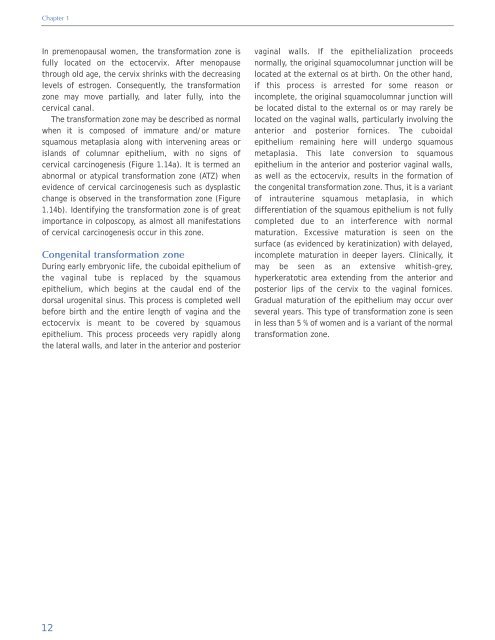Colposcopy and Treatment of Cervical Intraepithelial Neoplasia - RHO
Colposcopy and Treatment of Cervical Intraepithelial Neoplasia - RHO
Colposcopy and Treatment of Cervical Intraepithelial Neoplasia - RHO
Create successful ePaper yourself
Turn your PDF publications into a flip-book with our unique Google optimized e-Paper software.
Chapter 1<br />
In premenopausal women, the transformation zone is<br />
fully located on the ectocervix. After menopause<br />
through old age, the cervix shrinks with the decreasing<br />
levels <strong>of</strong> estrogen. Consequently, the transformation<br />
zone may move partially, <strong>and</strong> later fully, into the<br />
cervical canal.<br />
The transformation zone may be described as normal<br />
when it is composed <strong>of</strong> immature <strong>and</strong>/or mature<br />
squamous metaplasia along with intervening areas or<br />
isl<strong>and</strong>s <strong>of</strong> columnar epithelium, with no signs <strong>of</strong><br />
cervical carcinogenesis (Figure 1.14a). It is termed an<br />
abnormal or atypical transformation zone (ATZ) when<br />
evidence <strong>of</strong> cervical carcinogenesis such as dysplastic<br />
change is observed in the transformation zone (Figure<br />
1.14b). Identifying the transformation zone is <strong>of</strong> great<br />
importance in colposcopy, as almost all manifestations<br />
<strong>of</strong> cervical carcinogenesis occur in this zone.<br />
Congenital transformation zone<br />
During early embryonic life, the cuboidal epithelium <strong>of</strong><br />
the vaginal tube is replaced by the squamous<br />
epithelium, which begins at the caudal end <strong>of</strong> the<br />
dorsal urogenital sinus. This process is completed well<br />
before birth <strong>and</strong> the entire length <strong>of</strong> vagina <strong>and</strong> the<br />
ectocervix is meant to be covered by squamous<br />
epithelium. This process proceeds very rapidly along<br />
the lateral walls, <strong>and</strong> later in the anterior <strong>and</strong> posterior<br />
vaginal walls. If the epithelialization proceeds<br />
normally, the original squamocolumnar junction will be<br />
located at the external os at birth. On the other h<strong>and</strong>,<br />
if this process is arrested for some reason or<br />
incomplete, the original squamocolumnar junction will<br />
be located distal to the external os or may rarely be<br />
located on the vaginal walls, particularly involving the<br />
anterior <strong>and</strong> posterior fornices. The cuboidal<br />
epithelium remaining here will undergo squamous<br />
metaplasia. This late conversion to squamous<br />
epithelium in the anterior <strong>and</strong> posterior vaginal walls,<br />
as well as the ectocervix, results in the formation <strong>of</strong><br />
the congenital transformation zone. Thus, it is a variant<br />
<strong>of</strong> intrauterine squamous metaplasia, in which<br />
differentiation <strong>of</strong> the squamous epithelium is not fully<br />
completed due to an interference with normal<br />
maturation. Excessive maturation is seen on the<br />
surface (as evidenced by keratinization) with delayed,<br />
incomplete maturation in deeper layers. Clinically, it<br />
may be seen as an extensive whitish-grey,<br />
hyperkeratotic area extending from the anterior <strong>and</strong><br />
posterior lips <strong>of</strong> the cervix to the vaginal fornices.<br />
Gradual maturation <strong>of</strong> the epithelium may occur over<br />
several years. This type <strong>of</strong> transformation zone is seen<br />
in less than 5 % <strong>of</strong> women <strong>and</strong> is a variant <strong>of</strong> the normal<br />
transformation zone.<br />
12
















